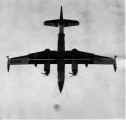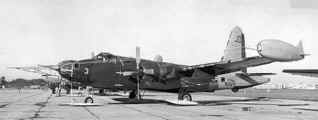-
- Lockheed Aircraft
- P2V-2N / P2V-7LP / LP-2J "Neptune"
|
-
- 122465
- P2V-2N
- "Boopsie"
|
-
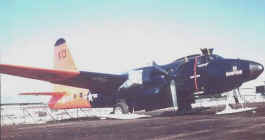 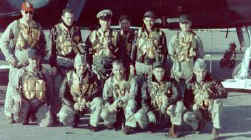
- Crashed during landing at McMurdo, Antarctica on Oct 18, 1956 in support of
Operation Deep Freeze II.
- Departed Christchurch NZ to McMurdo along with other the other long range aircraft of
VX-6.
- After passing the PSR (point of safe return) a severe storm enveloped the McMurdo area.
- Since they had insufficient fuel to return to Christchurch they were committed to flying
into the storm and landing at McMurdo.
- On Oct 18, 1967 122465 was the first aircraft to reach McMurdo with Lt. David W. Carey
as the pilot.
- Carey made a ground controlled approach from 12,000 feet to 300 feet and then elected to
make a visual landing.
- With the landing gear down the plane began to turn right.
- The nose of the plane fell, and the Neptune struck the snow on the nose and right wing.
- The Neptune was completely demolished.
- LT Dave Carey, AT1 Charles Miller, and AD1 Marian Marze were killed on impact.
- Capt. Rayburn Hudman died of his injuries a few hours later. Four others on the Neptune
were injured.
- (from: United States aircraft losses in Antarctica)
-
- To honor the crew of Boopsie they had Antarctic features named after them.
- LT Cary and CAPT Hudman they both had glaicers named after them.
- AT1 Miller and AD1 Marze both had twin summit mountain peaks named after them, Miller
Peak and Marze Peak.
- Miller Peak is located on a ridge between Hudman and Carey Glaciers and Marze Peak is
located on the other side of Hudman Glaicer. These landmarks are located at the South end
of the Sentinel Range in the Ellsworth Mountains.
- (Billy Ace Baker)
|
-
- 122466
- P2V-2N
- "Amen!"
|
-
- Crashed while in enroute to Antarctica, Feb 8, 1956 in support of Operation Deep Freeze
I.
- On Feb 3, 1956, a UC-1 "Otter" crashed near mile 38 of the Army-Navy Trail.
The crashed Otter and one HO4S-3 helicopter were the only aircraft at Little America
V. Rear Admiral George Dufek ordered other Otters to be shipped via ship from
McMurdo to Little America V. 122466 which had already returned to NAS Patuxent River, MD,
was ordered back to Antarctica for the search.
- In route both engines failed and it crashed in a remote jungle swamp in Venezuela.
All 8 crewmembers were rescued, and the Neptune was written off as a loss.
- (from: United States aircraft losses in Antarctica)
|
| |
- The first two P2Vs (122465 & 122466) were built for Highjump II which was to follow
Operation Windlmill, but Highjump II was cancelled due to the Korean War.
-
- The P2V-N2s were modified for polar work including skis and were to be used for
photography and scientific work.
-
- The two P2V-N2s were the same ones that were assigned to VX-6 and made the historic
flight from CHCH to McMurdo during DF-I.
The following is quoted from Operation Highjump II an Exercise in Planning. Monograph
Number Two In A Series:
Characteristics of Lockheed Model P2V-N2
Lockheed Model History, Model 26, P2V Neptune
Lockheed Aircraft Corporaton. Report No E.S. 22012, page 3-88-September 1951
3.4.1.2.2 P2V-N2. The two P2V-2N airplanes were developped for photograph reconnaissance
in Antarctica. Development of skis was conducted to enable operaiton on snow-covered
terrain. The range of this P2V-2N was 4790 nautical miles. It carried photographic and
special navitational equipment, as well as a Magnetic Airborne Detector (MAD) installation
which replaced the tail turret. All armament was deleted, including the nose guns and the
deck turret. Fuel capacity was 4647 gallons and the maximum gross weight was 72,000
pounds. - Billy-Ace Baker
|
-
- 140434
- P2V-7LP
- "George"
|
-
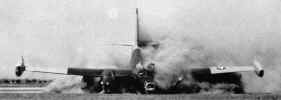 - Official CA ANG photo from the P2V Research webpage
-
- Crashed while landing Aug 11 1958 prior to Operation Deep Freeze IV.
- While landing at after an acceptance checkflight at Ontario, California, a ski
malfunctioned and the Neptune was destroyed. No one
- was injured. Since the deployment to Antarctica was near and there was not a replacement
Neptune, this loss was never made up.
- (from: United States aircraft losses in Antarctica)
|
-
- 140436
- P2V-7LP / LP-2J
- "Candid Camera"
|
-
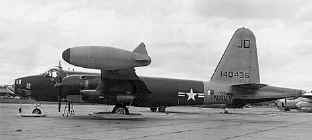 - Photo from the P2V Neptune website
-
- Escaped the scrapper's torch and is located in the Walter Soplata Collection (440)
564-5326.
- Give them a call and ask about 140436. It's a damn shame that this aircraft that has so
much VX-6 history is locked up and that the Soplata's won't even allow the Fine Personnel
of VX-6 to visit or photograph this aircraft.
-
|
-
- 140437
- P2V-7LP / LP-2J
- "City of Auckland"
|
-
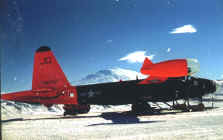 - Photo from the P2V Neptune website / Jay Slagle Collection
-
- Scrapped at Davis-Monthan
- (from: P2VNeptune.org)
|
-
- 140439
- P2V-7LP
|
-
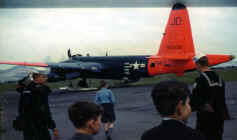 - Photo from the P2V Neptune website / Jay Slagle Collection
-
- Crashed while taking off from Wilkes Station, Antarctica, Nov 9 1961 in support of
Operation Deep Freeze 1962.
- While taking off from the skiway at Wilkes Station Antarctica the Neptune caught fire
and crashed. Of the nine men on board, only four survived.
- Killed were Dr. Edward C. Thiel, LCDR William C. Counts, LTJG Romauld P. Compton,
AMH1 William W. Chastain, and AD2R James L. Grey.
- A investigation of the crash reported the cause as a collision with the ground following
an intense, uncontrollable fire in the landing gear - bomb bay fuel tank area.
- (from: United States aircraft losses in Antarctica)
-
- To honor the crew of 140439 they had Antarctic features named after them.
Edward Thiel had the Thiel Mountains and the Thiel Trough named after him. LCDR William D.
Counts also has two features named in his honor; the first is Mount Counts, the second is
the Counts Icefall. LTJG Compton has the ice filled Compton Valley named in his honor.
Chastain Peak was named for Petty Officer Chastain. Petty Officer Gray has a rocky spur;
Gray Spur which is next to
Counts Icefall. It is only fitting that all of the land marks honoring the men killed in
this crash are located together in the Thiel Mountains. They died together and they are
immortalized together.
-
- From: BUZSAM@aol.com
Date: Mon, 29 May 2000
Subject: More info on Wilkes crash- CO
Joe,
I flew the C-130 to Wilkes to review the crash and pick up the survivors. I walked the
entire runway with Cdr Forsht , our maint officer at the time. We found parts that were
falling off the P2V from the beginning of its take off slide. The landing had been so
violently rough that it had broken loose the 400 gal internal tank in the bomb bay and the
4" filler pipe was spewing out raw fuel running down the bottom of the plane on take
off. At the ignition of the JATO on the t/o run, it acted like a Roman Candle. With the
burning of the fiberglass tail cone, all of the acrid smoke was drawn right up to the
cockpit and the pilots were blinded. They tried to return to the field and just couldn't
make it. The pilot managed to level the wings before they hit and that saved some of the
guys. We took the body bags and survivors back to McMurdo, after Cdr Forsht finished his
exam of the area and what was left of the plane. All below the snow line was pretty much
in tact and all above the snow line looked like a skeleton. Some where in my treasures I
have an icicle of the planes skin that had melted from the extreme heat and as it dripped
down through the frigid air, it hardened.
It wasn't a pleasant flight either way.
Hope this adds a little to your info.
Buz
|
-
- Photo by Jim Waldron JWALDRON@aol.com
This photograph was taken in December 1956 at the South Pole Station.
- The P2V aircraft had just arrived from McMurdo and was being unloaded.
- The photograph was taken from the cockpit of the R4D aircraft which
- had also just arrived from McMurdo.
Jim Waldron
|
-
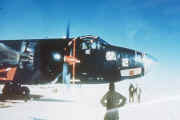
|
-
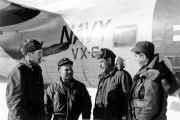
|
-
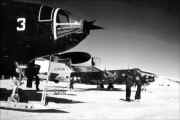
|
-
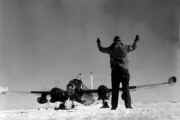
|
-
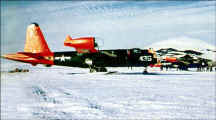
|
-
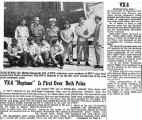
|
-
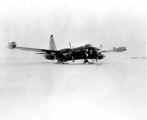
|
-
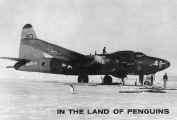
|
-
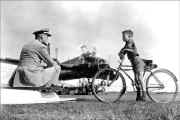
|
-
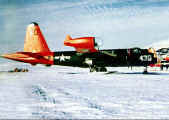
|
-
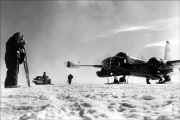
|
-
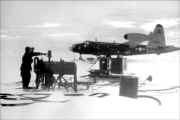
|
-
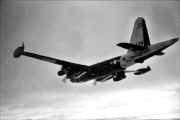
|
-
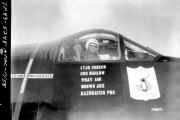
|
-
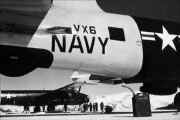
|
-
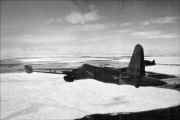
|
-
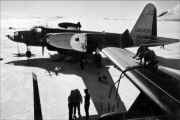
|
-
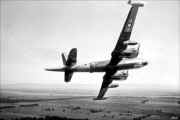
|
-
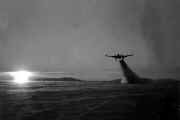
|
-
-
|
-
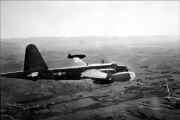
|
-
- All of the above photos are from the VXE-6 De-Com CD
|
-
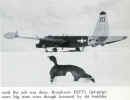 - Photo from DF II Cruise Book
- From Billy-Ace Baker
|
-
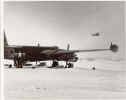 - Photo from Bruce Raymond
|
-
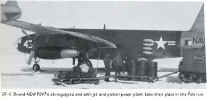 - Photo from DF II Cruise Book
- From Billy-Ace Baker
|
|
-
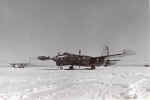
|
-
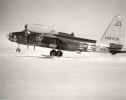
|
-
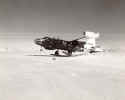
|
-
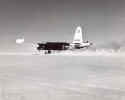
|
-
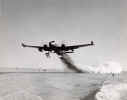
|
-
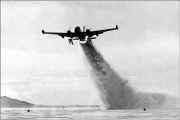
|
-
- P2V-7LP JATO launch McMurdo Sound 1959.
- Photos from Bruce Raymond
|
-
 -
- US Navy Photo
- by PH1 Mathis
- From Bruce Raymond
|
-
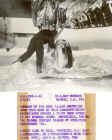 -
- US Navy Photo by
- PH1 Mathis
- From Bruce Raymond
|
-
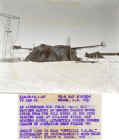 -
- US Navy Photo
- by PH3 Woods
- From Bruce Raymond
|
-
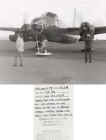 - US Navy Photo
- Photo from Bruce Raymond
|
-
|
-
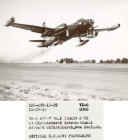 - US Navy Photo
- Photo from Bruce Raymond
|
-
- VX-6 P2V's are used in the development of the FULTON RECOVERY SYSTEM
-
- Project SKYHOOK and Operation Coldfeet
-
- From the CIA's Center for the Study of Intelligence:
- - A good pick-me-up by William M. Leary
-
- One of the most unusual and inventive CIA operations
- http://www.cia.gov/csi/studies/95unclass/Leary.html
-
In March 1962, the mission planners received the unexpected news that the Soviets had
abandoned ice station NP 8 in haste after a pressure ridge destroyed its ice runway. A
more up-to-date facility than NP 9, it also was in a more accessible position at 83¡N
135¡W. "With the operation finally about ready to take off," Cadwalader
reported, "the target was shifted to this new and tempting target." After the
Canadian Government readily agreed to the use of the Royal Canadian Air Force base at
Resolute Bay, 600 miles from NP 8, Project Coldfeet got under way.
In mid-April, the P2V and a C-130 support aircraft from Squadron VX-6 departed Patuxent
River for Resolute Bay via Fort Churchill. Captain Cadwalader, the project's commander,
had hoped that the Hydrographic Office's monthly ice reconnaissance flight that flew
between Thule and Point Barrow would provide an up-to-date position on NP 8; bad weather
and a navigational error, however, prevented a sighting. Still, with the last known
position only a month old and given the general dependability of the Hydrographic Office's
drift predictions, he expected no difficulty in finding the target. The C-130 carrying the
drop party would locate NP 8, while the P2V would be standing by in case an immediate
extraction was necessary.
The hunt for NP 8 began in perfect weather. The C-130 flew to the station's last known
position, then began a box search at 10-mile intervals. Hours went by, but nothing could
be seen except ice. The next day, the C-130 started searching at five-mile intervals. It
spotted the abandoned US Ice Station Charlie but not NP 8. Four more searches failed to
reveal the elusive Soviet drift station. With the flight time available for the C-130
running out and the weather deteriorating, Cadwalader called off the operation.
- Click here to read the rest of the article
http://www.cia.gov/csi/studies/95unclass/Leary.html
|
-
- Photo from Art Herr
|
-
- Photo from the P2VNeptune.org website
|
-
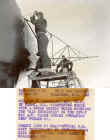 - US Navy Photo by PH2 Williams
- From Bruce Raymond
|
-
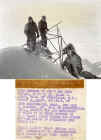 - US Navy Photo by PH2 Williams
- From Bruce Raymond
|
-
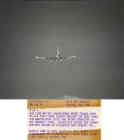 - US Navy Photo by PH3 Paxton
- From Bruce Raymond
|
-
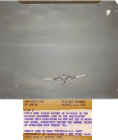 - US Navy Photo by PH3 Paxton
- From Bruce Raymond
-
|
-
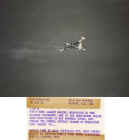 - US Navy Photo by PH3 Paxton
- From Bruce Raymond
|
-
- Subject: recovery system
Joe, Sean and others,
I sent Joe's message with the URL about the Fulton Recovery System to Art Herr. Here's his
reply.
Bob N
Subject: Re: Fulton Aerial Retrieval Invention
Bob---How very interesting that you [forwarded] this article! When I first arrived at
VX-6, then based at Quonset Point RI, the ski P2V-7's were still on board. Matter-of-fact
I was placed in training to fly them.
Sometime that first year Robert Fulton arrived with his team and proceeded to rig one of
our Neptunes with his retrieval apparatus. I remember Fulton as a real science-fiction
type of character---a very interesting but intense kind of person. On one of the first
test flites, the retrieval cable wrapped around the rudder and the crew had a very
difficult landing situation. As I recall the project suffered some credibility after that
and the P2's were shortly to be phased out anyway.
- We did deploy with the Neptune's in '62, but in an accident not involving the retrieval
system, Buno 140439. a P2V-7LP crashed at Wilkes Station with five fatalities. In the
Squadron Cruise book ( the edition which is now a collectors item -- "20 Years On the
Ice" ) there is photograph (from below) of a P2V rigged with the Fulton invention.
Art Herr
|
-
- Bvfd101@aol.com
Date: Sun, 28 May 2000
Subject: Re: [OAEs] Fulton
He next used a pig, as pigs have nervous systems close to humans. Lifted off the ground,
the pig began to spin as it flew through the air at 125 mph. It arrived on board undamaged
but in a disoriented state. Once it recovered, it attacked the crew.....
|
-
- That is all very interesting stuff...( saw John Wayne use one in a movie)...one question
about the testing....are they sure that's how the sheep died and how did they cook the pig
?
Ron
|
-
- Ron,
The rest of the story: After the crew got back on the ground, the pig was returned to its
cage.
- Postflight included cleaning up the interior of the Neptune as the pig relieved himself
and getting new flight suits issued.
Nerves frazzled by the event, the crew retired to the Sea-Air Club for a few beers.
- While there, they were talking loudly about the pig in a very negative fashion.
- One of the "Local Lovelies" overheard some of the remarks and mistook the
conversation as being directed at her.
- She attacked with a vengeance.
- The crew secured to the barracks.
- Being attacked and mauled by two pigs in one day was more than they could stand.
Regards, Jim Landy, Gaffer
|
-
- SEAN MILLIGAN jetsarekids@ids.net
Date: Sun, 28 May 2000
Subject: Re: [OAEs] re:recovery system
Bob --
That's it !!! Thanks for exonerating me!
What I saw at Quonset was this airplane. The full assembly was not rigged - Just the first
two feet or so that came right out of the tip of the Plexiglas nose. Sad to hear about the
crash. This P2V was on display at the Navy Relief Carnal and Air Show with the Blues -
August of '62, I think.
Memorial Day Remembrance
Semper Fi
Sean, OVER.
|
-
- From: Izzy Gantz gantzc001@hawaii.rr.com
Date: Sat, 27 May 2000
Subject: Re: [OAEs] recovery system
Sean, I was aboard the USS Lake Champlain (HS-5) when they used that P2V to pick up Sand
Bags. We weren't allowed on the flight deck to watch (only a brown shirt). The weather was
socked in for the first try and I can't say for sure if another attempt was made but I do
know that we were slated for that trial run
- Smile, Today is the first day of the rest of your life!
Izzy
|
-
|
-
- The P2V Neptune website
-
- The Lockheed P2V Neptune Research Project Pages
-
- VP Navy
-
- P2V Neptune: Forgotten Warbird
-
- The Lockheed P2V Neptune by Vectorsite
-
|









































